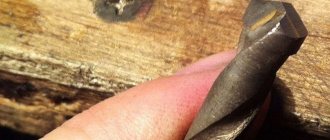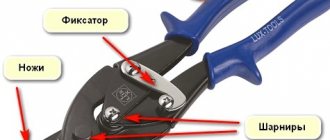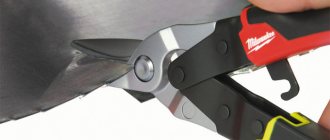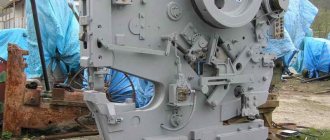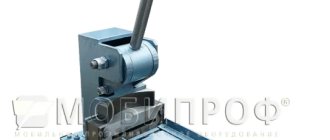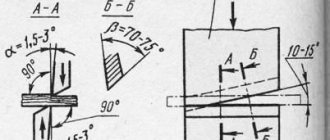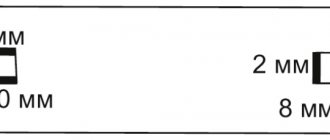Lever shear device
The operation of manual metal shears is based on the principle of leverage. The cutting of the material is carried out by two cutting surfaces about 20 cm long. In this case, one surface is rigidly fixed to the base, and all the pressure is applied here. The movable cutter is also fixed to the frame. A groove is selected in the fixed blade to move the slider. It moves like a hinge in one plane.
The movable part of the scissors is attached to the slider. The working stroke of the slider is 15 - 32 mm. The movable panel is equipped with a long handle (about 50 cm), which increases the applied force by 20 times or more. Therefore, metal is cut quite easily.
The body of the lever scissors is metal, the cutting surfaces are made of tool steel. On average, the dimensions of the instrument are 56 x 18 x 45 cm and weighs about 30 kg. Using such equipment, you can cut a steel sheet with a thickness of 0.5 cm, aluminum or brass 0.6 mm, a profile with a section of 6x70 mm or a steel rod No. 13 with your own hands.
How to make roller shears for metal from bearings
When the question is: “buy or make it yourself,” most often home craftsmen opt for the second option. Simply because it's cheaper.
Necessary materials:
- steel square bar;
- fittings;
- bearings;
- bolts;
- metal strip.
Making levers
From a square rod we cut two pieces of the same length. We retreat about 1 cm from the edge and drill holes.
Then use a tap to cut the threads in the holes. Using bolts, we attach bearings to the ends of the arms.
We also drill holes at the opposite ends of the square rods. In one of them we cut a thread with a tap. We connect the levers together using a bolt.
Setting the limiter
We will need a piece of metal strip that will act as a limiter. We drill a hole at the end and cut a thread in it.
We weld the workpiece to the lower arm. We cut off the excess with a grinder. Screw the bolt into the hole.
We weld the strip to the lever
Cut off the protruding part
The finished result
Making a pen
You can use a piece of reinforcement or a corrugated square rod as a handle. We give the workpiece the required shape and weld it to the upper arm. The homemade device is ready!
Now all that remains is to clean the welds with a grinder and, if desired, paint the homemade product.
Types of lever scissors
The designs of lever cutters do not differ in variety; the main difference is in the type of drive:
- manual - the most primitive device; by pressing the lever, the cutting blade is set in motion;
- electric - they work very quickly and are highly efficient. Cutting metal on such equipment does not require any effort from the worker;
- hydraulic - powerful, driven by a hydraulic drive. Widely used when large forces are required, for example, for cutting reinforcement or rods.
Hand scissors are divided depending on their purpose and design:
- with straight blades - used only for cutting in a straight line;
- with curved cutters - they are used to cut out complex shaped elements and holes;
- chair - used for cutting thick layers of paper;
- finger - make holes with very thin incisors;
- lever - permanently mounted on a workbench.
The manual lever attachment allows for through or straight cutting on a straight line only.
In addition, the tools differ in the length of the actuators:
- with short blades for through cutting;
- with long cutting surfaces - for straight cutting;
- combined scissors for all types, including contour scissors.
Cutting small parts with lever scissors is impossible; they are convenient for large cutting or chopping work.
The tool can be stationary or portable. For work, both types are firmly fixed on a workbench or bed. This is the only way to cut metal accurately and safely. To secure portable scissors, use clamps or bolts.
Characteristics of scissors
The intended purpose of roller knives is to cut steel sheets up to 1 mm thick. They are necessary at the site for the production of ventilation ducts, when working with roofing metal, when building a fence and arranging the roof.
The mechanism is used to produce semi-finished products for subsequent bending of profiles for various purposes. The equipment is installed in car body repair shops. In auxiliary production, blanks are prepared for the assembly of racks and cabinets.
Roller scissors can successfully replace the manual version or guillotine due to a number of advantages:
- Compact dimensions and light weight.
- Simple device.
- Convenient to use.
- Just getting set up.
- Suitable for working with sheets of different materials: aluminum, tin, steel, roofing iron.
The processed product is obtained with a clean cut and no burrs or bends. It is easy to cut sheet metal with such a device.
Scissors can be purchased at a specialized store or made independently. It all depends on the volumes performed and the economic component. With a daily cutting rate of 30–50 meters or more, an industrial design will be required.
Rules for working with lever shears
Before starting work, you must put on seals so as not to get cut by the sharp edges of the metal sheet!
- Firmly fix the hand tool on the table surface;
- place the sheet of metal perpendicular to the blades, holding it with your main hand (right hand for right-handers);
- Smoothly and carefully press the handle from top to bottom.
While working, you need to protect your feet from falling pieces of cut metal. Falls on the edge are especially dangerous, so you should not work barefoot or in open shoes. To install the scissors, choose only a solid, non-wobbly base.
Homemade lever scissors
Option 1
- The frame of this model of hand scissors is assembled with your own hands from a pair of corners 7.5 x 7.5 x 0.8 cm. The fixed knife is attached to a horizontal base using a pair of screws. To align with the movable blade, the top of the base is cut in half. Holes are made in the blades, countersunk for M8 screws 24 mm long, countersunk.
- On the upper base, with the help of hinge fasteners, the following are installed: on the lower surface, the blade and lever of the knife (dimensions 6.5 x 3 x 0.6 cm), on the upper part, the lever (24.5 x 1.8 x 0.7 cm) and the earring (6 x 1.8 x 7 cm), providing mobility.
The blanks are cut out with your own hands using a hacksaw. The blades are machined from hardened steel, the sharpening angle is 30 degrees.
First, we assemble all the parts into the finished machine and set it up. Then we take it apart and paint it. When the paint dries, we assemble it clean.
Since the presented structure is quite small, it is mounted on a workbench in a vice. You can install the tool permanently on a workbench. To do this, the base is welded to a corner, which is screwed to the workbench. Spacers are used to adjust the blade ratio.
Option 2
This model of hand scissors is complemented by a detailed drawing. Metal cutting is done with a pair of blades, each 10 cm long. The movable blade is attached to the slide on a crank mechanism. The crank eccentricity is 16 mm and gives a maximum amplitude of 3.2 cm. We attach a 50 cm long handle to its tail.
It is recommended to make a stationary version of the scissors, which will be securely attached once to the working surface with M10 bolts. For fastening, paws with holes are provided. The body of lever hand scissors must be made of high-quality steel 45 or 40, and the blades from grades P18, P9 or U10.
Scissors made according to this drawing have been working successfully for more than 2 years, coping with steel sheets up to 3.5 mm thick.
Video with a detailed description of the drawings, design and manufacture of lever metal shears:
Cutting rules
Basic rules that must be applied when cutting sheet metal with hand scissors:
- When marking a part that needs to be cut, you need to provide an allowance for subsequent processing.
- Position the sheet to be cut strictly perpendicular to the blades of the tool.
- Cutting should be done in mittens with sharpened scissors.
- To avoid tearing the metal, you do not need to bring the device completely together at the end of the cut.
- It is necessary to tighten the screw axis if the tool begins to crush the workpiece material.
- If it is difficult to press the handles of the device or the thickness of the metal is 0.5 mm or more, you need to secure one of the handles in a vice.
- The size of the “cut” in the corners should not be more than 0.5 mm.
- If you need to cut a part with a curved shape, first cut the workpiece with a straight cut with an allowance of five to six millimeters, then cut the part clockwise according to the markings.
How to make a guillotine for cutting metal with your own hands?
In a home workshop or small business producing products from thin sheet metal, sheet metal shears, more simply - a guillotine - will never be superfluous. The driven version can be installed, for example, in a garage, and a manual guillotine will not take up much space at all. If you have a fairly large number of manufacturing options (in drawings, videos or descriptions), as well as some adapted components from some decommissioned equipment, making homemade metal shears is an accessible reality.
The work of the simplest metal scissors
The principle of cutting with guillotine (sheet) shears is that the knife beam of the device, to which the movable part of the tool is attached, along the working end must have an angle of 1.5...3°, as a result of which metal cutting occurs non-simultaneously across the entire width. This reduces the cutting force, but requires a technique that would compensate for the shear of sheet metal (tin, thick cardboard, etc.) during cutting. Thus, a reliable clamp is required.
The main components of the saber guillotine
To drive a homemade guillotine, you can use a low-power electric motor, since the energy intensity of the process is low. But based on the results of calculating the maximum cutting force, a manual drive, for example, a lever type, is often sufficient (this is often what is offered in home-made devices). You will also need reliable guidance of moving parts during the cutting process, as well as a rigid support surface for the bed. In this case, the parts of the homemade guillotine and the product itself will not be elastically deformed.
The drawings usually indicate the limits of the thickness and width of the sheet metal or tin for which the device is designed. If the entire process of obtaining sheet shears with your own hands is carried out independently, then the design begins with clarifying the power characteristics of cutting and choosing a mechanism diagram.
The initial data for choosing a design are:
- the type of material with which operations will be performed;
- maximum sheet dimensions in terms of thickness, length and width;
- separation accuracy;
- maximum overall dimensions of scissors;
- type of drive.
Operating principle and design features
Unlike sheet metal shears with an inclined knife (guillotine), the movement of the knife in lever shears most often occurs not along a translational path, but along a rotational path. In addition, the main actuator is not a crank-slider, but a lever.
Lever scissors, assembled according to the single-arm lever design, have become most widespread. When cutting thin metal, with a thickness of no more than 0.7...0.8 mm, hand-held shears are used, and when cutting thicker metal, chair scissors are used, the lever of which is much longer. In addition, the chair scissors designs provide for the possibility of integrating an intermediate gear drive. This increases the length of the moving knife path, but reduces the resulting force, which is important if the unit is manually driven.
The largest versions of chair scissors allow cutting rolled steel sheets with a thickness of up to 8...10 mm, and long products with a diameter of no more than 22 mm.
Manually operated chair lever scissors are designed so that the driving arm is shaped like a saber. This makes it possible to bring the trajectory of movement closer to the operation of guillotine shears: the introduction of the moving part of the working tool into the metal being cut also occurs gradually. As a result, the current cutting force value is reduced. Non-powered (manual) chair-type scissors can cut steel up to 2…2.5 mm thick.
The typical design of desktop lever scissors is a combination of the following components:
- beds;
- eccentric or screw clamps, by means of which equipment can be permanently attached to a bench;
- lower support frame on which the fixed part of the equipment is installed;
- saber-shaped rotary lever with handle (for manual models). a movable part of the equipment is installed on it;
- axles with plain bearings.
In the drive lever shears, in addition to the above components, there is also an electric motor, a V-belt drive, as well as a crank mechanism, which converts the rotational movement of the motor shaft into the rocking movement of the lever. Sometimes such equipment is equipped with an activation mechanism (clutch and brake), and in this form they are not much different from stationary alligator-type scissors. Their only advantage in this case is the absence of a balancer to compensate for the inertia of massive parts.
Mechanical guillotine shears
The manual device is the simplest in design. It includes:
- support table on which the initial workpiece will be located;
- two or four racks that will provide the scissors with strength and stability;
- a rotary axis with plain bearings (rolling bearings are unsuitable, since the clearances during operation of such a guillotine will change significantly, which will quickly lead to jamming);
- a knife beam, which provides seats for fastening replaceable knives;
- fixed knives, which are mounted on the front end surface of the work table;
- a rotary lever that will forcefully move the beam during cutting;
- clamps for fixing metal.
Do-it-yourself production starts from the table. Its dimensions must be sufficient for convenient placement of the workpiece, taking into account the places for fixing clamps: there must be at least two of them, on each side of the sheet. The thickness should prevent deflection under deformation forces. The easiest way is to use a steel plate, which you install on the channels yourself. The joints can be bolted flush with the top surface, or welding can be used. The front end must be ground to ensure evenness of the subsequent fit of the stationary knife to it.
The next stage is to obtain support posts with your own hands. They must be made from a solid profile. Square pipes made of high-quality medium-carbon steel or a channel are suitable. The section size can be easily calculated from the maximum load on the racks, which is the sum of the self-weight of the components of manual guillotine shears for metal, and the cutting force P, kN.
The latter is calculated according to the dependence:
k is a coefficient that takes into account possible unevenness of the working gap, bluntness of cutting edges, quality of the material being cut, etc. Typically k = 1.05…1.3;
B – maximum width of the metal sheet, mm;
s – maximum metal thickness, mm;
σav – ultimate shear strength of the material, MPa.
For the materials most commonly used in everyday life, this parameter is, MPa:
- for low-carbon steel – 280…290;
- for medium carbon steel – 300...400;
- for high carbon and stainless steel – 400…500;
- for sheet metal, aluminum – 65...80;
- for copper, brass – 180...200.
When assembling the racks with your own hands, it is imperative to maintain the parallelism of the supporting surfaces and their perpendicularity to the axis of rotation of the knife beam. For these purposes, it is better to use a laser level. The floor where the scissors are installed must be made level and durable. Do-it-yourself installation of equipment on compacted soil, laminate and other options for coating concrete with polymers is not allowed.
A particularly important moment is making a knife beam with your own hands: its profile must be made such that during the turning process the movable knives gradually come into contact with the metal being cut. There are two options for this:
- profiling along the contour of the saber, with a gradual increase in the radius of curvature as it approaches the lever handle;
- pyramidal profile with a bevel angle of no more than 5...60 (at a larger angle, the metal will begin to deform and bend in the direction of the rotation axis).
The saber-shaped profile is more difficult to make, but it provides a smoother integration into the metal being cut.
For better direction of the body, it is placed either in a special groove on the table, or - with increased deformation forces - special guides are designed, which are attached to the racks with your own hands.
Handmade homemade guillotine
It is better to make the rotation axis from high-quality carbon steel, and then harden it to a hardness of at least 42…45 HRC. Bearing bushings are made of OF10-1 bronze, which has good wear resistance.
For the manufacture of tools, tool steels U10 or U12 are used, hardened to a hardness of 48...54 HRC. Hardened knives are carefully polished with your own hands, after which they are sharpened at an angle of 85...90°. The gap between the knives is taken within 3...6% of the thickness.
If you find an error, please select a piece of text and press Ctrl+Enter.
Lever shear device
The operation of manual metal shears is based on the principle of leverage. The cutting of the material is carried out by two cutting surfaces about 20 cm long. In this case, one surface is rigidly fixed to the base, and all the pressure is applied here. The movable cutter is also fixed to the frame. A groove is selected in the fixed blade to move the slider. It moves like a hinge in one plane.
The movable part of the scissors is attached to the slider. The working stroke of the slider is 15 - 32 mm. The movable panel is equipped with a long handle (about 50 cm), which increases the applied force by 20 times or more. Therefore, metal is cut quite easily.
The body of the lever scissors is metal, the cutting surfaces are made of tool steel. On average, the dimensions of the instrument are 56 x 18 x 45 cm and weighs about 30 kg. Using such equipment, you can cut a steel sheet with a thickness of 0.5 cm, aluminum or brass 0.6 mm, a profile with a section of 6x70 mm or a steel rod No. 13 with your own hands.
Lever metal shears: photos, videos and DIY creation
Lever metal shears are a popular tool that is used to perform various procedures for cutting materials - sheet metal, tin, profiles, wire. Although all kinds of hand tools of this type are offered on the market, there are often adventurers who prefer to make guillotine devices with their own hands.
DIY drawing of lever shears for metal
- Guillotine devices for cutting metal are based on the lever principle of operation;
- The cutting process is carried out by a pair of cutting surfaces;
- In this case, the length of a knife for metal can be about 20 centimeters;
- One cutting surface is firmly fixed to the base of the machine and is subject to all the pressure while cutting metal;
- The moving part is located on the bed, which facilitates high-precision cutting;
- On a stationary blade, hand tools provide a special groove for the slide. It is designed to move the slider as needed. The groove carries out movements in one plane;
- The moving part of the cutter is connected to the slider;
- The working stroke of this slider is usually 15-30 millimeters;
- The movable knife is firmly connected to the handle, the length of which is about 500 millimeters. Due to this, during the cutting process you can apply less force with your own hands in order to cut sheet metal of the required quality;
- Guillotine devices have a metal body, which significantly extends the service life and increases the loads that the tool can handle when cutting sheet metal, profiles, and rods;
- Cutting knives are made of high-strength tool steel. This allows you to cut sheet metal parts with minimal effort and without deformation of the cutting edges.
Using guillotine hand tools for cutting metal, you can process with your own hands:
- Sheets of steel up to 5 millimeters thick;
- Products made of sheet aluminum up to 6 mm thick;
- Brass 6 mm thick;
- Metal profiles with a section of 6 by 80 mm;
- Steel rod No. 13.
Photo of using lever metal shears
To purchase hand-held cutting tools or make guillotine devices with your own hands, you will first need to become familiar with the types of these devices.
Structurally, lever scissors are almost no different from each other. Therefore, the main difference lies in the type of drive used. Hence the classification, dividing devices into three main categories.
- Hand cutters. These are the simplest cutting devices that require you to operate the blade with your hands to get the job done.
- Electrical. They are distinguished by high productivity and speed of work. To cut profiles, sheet metal, rods, you do not need to apply any physical effort.
- Hydraulic. The most powerful types of equipment, the operation of which depends on a hydraulic drive. Widely used in cutting the thickest and most durable materials. They are used extremely rarely in everyday life.
When choosing lever tools for cutting sheet metal, rods, profiles, you should pay attention to another important parameter - the length of the actuating tool. The capabilities of the scissors directly depend on the length of the blades.
There are three main types of scissors according to length:
- Short. They are small in size and allow continuous cutting of material;
- Long. These guillotine devices provide straight cutting, minimizing the effort and time required to process workpieces;
- Combined. They can cut sheet metal, metal profiles, rods in various ways. A distinctive feature is the ability to carry out contour cutting.
It is impossible to use lever scissors for processing small items. Their main purpose is cutting and cutting large workpieces and parts.
All factory lever scissors and homemade devices on the market can be divided into two large groups:
- Stationary. They are securely fixed on the desktop or workbench with special devices provided for by the design of the machine;
- Portable. Also designed for fixing on a work surface. But in this case, fastening is carried out with bolts or clamps. If necessary, they can be easily removed and moved to another area to perform the assigned tasks.
Hand scissors
Manual guillotine devices are most often preferred for home use. Their simple drawings allow you to make simple desktop units with your own hands. They do an excellent job cutting thin sheet metal.
But before you choose these hand tools, you need to know what varieties they come in. Such knowledge allows you to make homemade metal scissors if you wish. Although desktop factory models do not cost much, they will not require you to make significant financial outlays to purchase a tool for use at home with your own hands.
Types of lever scissors
The designs of lever cutters do not differ in variety; the main difference is in the type of drive:
- manual - the most primitive device; by pressing the lever, the cutting blade is set in motion;
- electric - they work very quickly and are highly efficient. Cutting metal on such equipment does not require any effort from the worker;
- hydraulic - powerful, driven by a hydraulic drive. Widely used when large forces are required, for example, for cutting reinforcement or rods.
Hand scissors are divided depending on their purpose and design:
- with straight blades - used only for cutting in a straight line;
- with curved cutters - they are used to cut out complex shaped elements and holes;
- chair - used for cutting thick layers of paper;
- finger - make holes with very thin incisors;
- lever - permanently mounted on a workbench.
The manual lever attachment allows for through or straight cutting on a straight line only.
In addition, the tools differ in the length of the actuators:
- with short blades for through cutting;
- with long cutting surfaces - for straight cutting;
- combined scissors for all types, including contour scissors.
Cutting small parts with lever scissors is impossible; they are convenient for large cutting or chopping work.
The tool can be stationary or portable. For work, both types are firmly fixed on a workbench or bed. This is the only way to cut metal accurately and safely. To secure portable scissors, use clamps or bolts.
Limitations of lever shears and how to overcome them
The main disadvantage of lever shears that do not have a mechanical drive is the need to make very long movements in order to reduce the force of cutting metal. In addition, with a manual drive it is impossible to ensure a constant cutting speed, which can deteriorate the quality of the metal cutting surface. By lengthening the drive, you have to sacrifice the overall dimensions of the equipment. In addition, lengthening the arm always worsens control over the quality of the workpiece clamp, and requires the use of more powerful clamps that hold the cut metal from moving. At the same time, there is also no possibility for high-quality cutting of profiled products: rods, angles, etc.
These limitations are overcome by designs with a multi-link cutting mechanism, as well as by the use of various methods of reinforcement without the participation of muscular force. In this case, a mechanical drive is not required.
Cutting Rules
In the first case, predominantly kinematic schemes with two levers are used. An additional one is added to the main lever (each part of which is connected to the other part using a common axis), and its connection with the main pair is achieved by the presence of a cylindrical rod with a rack and pinion drive.
The rack and pinion mechanism consists of the following parts:
- intermediate lever;
- return springs;
- swivel brackets;
- a screw pair connecting the rail with the intermediate rod.
This method, although it provides higher quality metal cutting, but significantly complicates the design of lever shears. It is very difficult to make such an option at home; in addition, the worker’s effort will remain quite high.
If instead of a rack and pinion transmission a mechanical amplifier is placed in the intermediate rod, the resulting load will noticeably decrease. This type of manual lever scissors includes, in addition to the main working elements, also:
- cylindrical hollow rod;
- amplifier with self-braking thread;
- connecting rod;
- spring-loaded lock;
- counterweight.
The presence of a load gives the metal cutting process an impact character, due to which it is possible to increase the cutting energy and separate workpieces with a larger thickness or cross-sectional area. However, the shock nature of the load application tires the worker (especially during prolonged work), and the amplitude of vibration of the device on the frame increases. To install such scissors, you will need more reliable support and a flat floor surface. Metal cutting performance will also decrease.
The three-tier scheme is considered the most modern. In this case, the required compromise is achieved between the applied force and the length of movement of the movable tool.
Rules for working with lever shears
Before starting work, you must put on seals so as not to get cut by the sharp edges of the metal sheet!
- Firmly fix the hand tool on the table surface;
- place the sheet of metal perpendicular to the blades, holding it with your main hand (right hand for right-handers);
- Smoothly and carefully press the handle from top to bottom.
While working, you need to protect your feet from falling pieces of cut metal. Falls on the edge are especially dangerous, so you should not work barefoot or in open shoes. To install the scissors, choose only a solid, non-wobbly base.
Homemade lever scissors
Option 1
- The frame of this model of hand scissors is assembled with your own hands from a pair of corners 7.5 x 7.5 x 0.8 cm. The fixed knife is attached to a horizontal base using a pair of screws. To align with the movable blade, the top of the base is cut in half. Holes are made in the blades, countersunk for M8 screws 24 mm long, countersunk.
- On the upper base, with the help of hinge fasteners, the following are installed: on the lower surface, the blade and lever of the knife (dimensions 6.5 x 3 x 0.6 cm), on the upper part, the lever (24.5 x 1.8 x 0.7 cm) and the earring (6 x 1.8 x 7 cm), providing mobility.
The blanks are cut out with your own hands using a hacksaw. The blades are machined from hardened steel, the sharpening angle is 30 degrees.
First, we assemble all the parts into the finished machine and set it up. Then we take it apart and paint it. When the paint dries, we assemble it clean.
Since the presented structure is quite small, it is mounted on a workbench in a vice. You can install the tool permanently on a workbench. To do this, the base is welded to a corner, which is screwed to the workbench. Spacers are used to adjust the blade ratio.
Option 2
This model of hand scissors is complemented by a detailed drawing. Metal cutting is done with a pair of blades, each 10 cm long. The movable blade is attached to the slide on a crank mechanism. The crank eccentricity is 16 mm and gives a maximum amplitude of 3.2 cm. We attach a 50 cm long handle to its tail.
It is recommended to make a stationary version of the scissors, which will be securely attached once to the working surface with M10 bolts. For fastening, paws with holes are provided. The body of lever hand scissors must be made of high-quality steel 45 or 40, and the blades from grades P18, P9 or U10.
Scissors made according to this drawing have been working successfully for more than 2 years, coping with steel sheets up to 3.5 mm thick.
Video with a detailed description of the drawings, design and manufacture of lever metal shears:
Exploitation
For safe use, you need to learn the rules for working with the equipment:
- Work using protective gloves and goggles.
- Secure the workpiece with an additional vice so that it does not move during work.
- Lubricate moving mechanisms with motor oil 1-2 times a month.
- If metal is chewed on electric shears, you need to unplug them and try to pull out the material yourself, without turning on the electric motor.
- Lower the lever smoothly, slowing down towards the end of the cuts.
- Keep your hand no closer than 10 cm from the sharp edge.
- Check how securely the parts being separated are held.
- Start electric models using an additional pedal, keep your hands further away from the blade.
The operating rules apply to both purchased and homemade machines.
Lever shears are used to separate different metal parts. Depending on the thickness of the workpiece that needs to be separated, you need to select a tool drive. If you wish, you can assemble them yourself and use them to help during construction or improvement of your home or site.
How to make a guillotine for cutting metal with your own hands?
In a home workshop or small business producing products from thin sheet metal, sheet metal shears, more simply - a guillotine - will never be superfluous. The driven version can be installed, for example, in a garage, and a manual guillotine will not take up much space at all. If you have a fairly large number of manufacturing options (in drawings, videos or descriptions), as well as some adapted components from some decommissioned equipment, making homemade metal shears is an accessible reality.
The work of the simplest metal scissors
The principle of cutting with guillotine (sheet) shears is that the knife beam of the device, to which the movable part of the tool is attached, along the working end must have an angle of 1.5...3°, as a result of which metal cutting occurs non-simultaneously across the entire width. This reduces the cutting force, but requires a technique that would compensate for the shear of sheet metal (tin, thick cardboard, etc.) during cutting. Thus, a reliable clamp is required.
The main components of the saber guillotine
To drive a homemade guillotine, you can use a low-power electric motor, since the energy intensity of the process is low. But based on the results of calculating the maximum cutting force, a manual drive, for example, a lever type, is often sufficient (this is often what is offered in home-made devices). You will also need reliable guidance of moving parts during the cutting process, as well as a rigid support surface for the bed. In this case, the parts of the homemade guillotine and the product itself will not be elastically deformed.
The drawings usually indicate the limits of the thickness and width of the sheet metal or tin for which the device is designed. If the entire process of obtaining sheet shears with your own hands is carried out independently, then the design begins with clarifying the power characteristics of cutting and choosing a mechanism diagram.
The initial data for choosing a design are:
- the type of material with which operations will be performed;
- maximum sheet dimensions in terms of thickness, length and width;
- separation accuracy;
- maximum overall dimensions of scissors;
- type of drive.
Design and principle of operation
The design of the device consists of two movable arms of equal length, hingedly connected to each other using a bolt.
At the ends of the levers there are cutting knives, which act as rotating rollers.
During operation, the rollers come into contact with their inner walls and are pressed into the sheet metal from above and below, due to which the material is cut.
